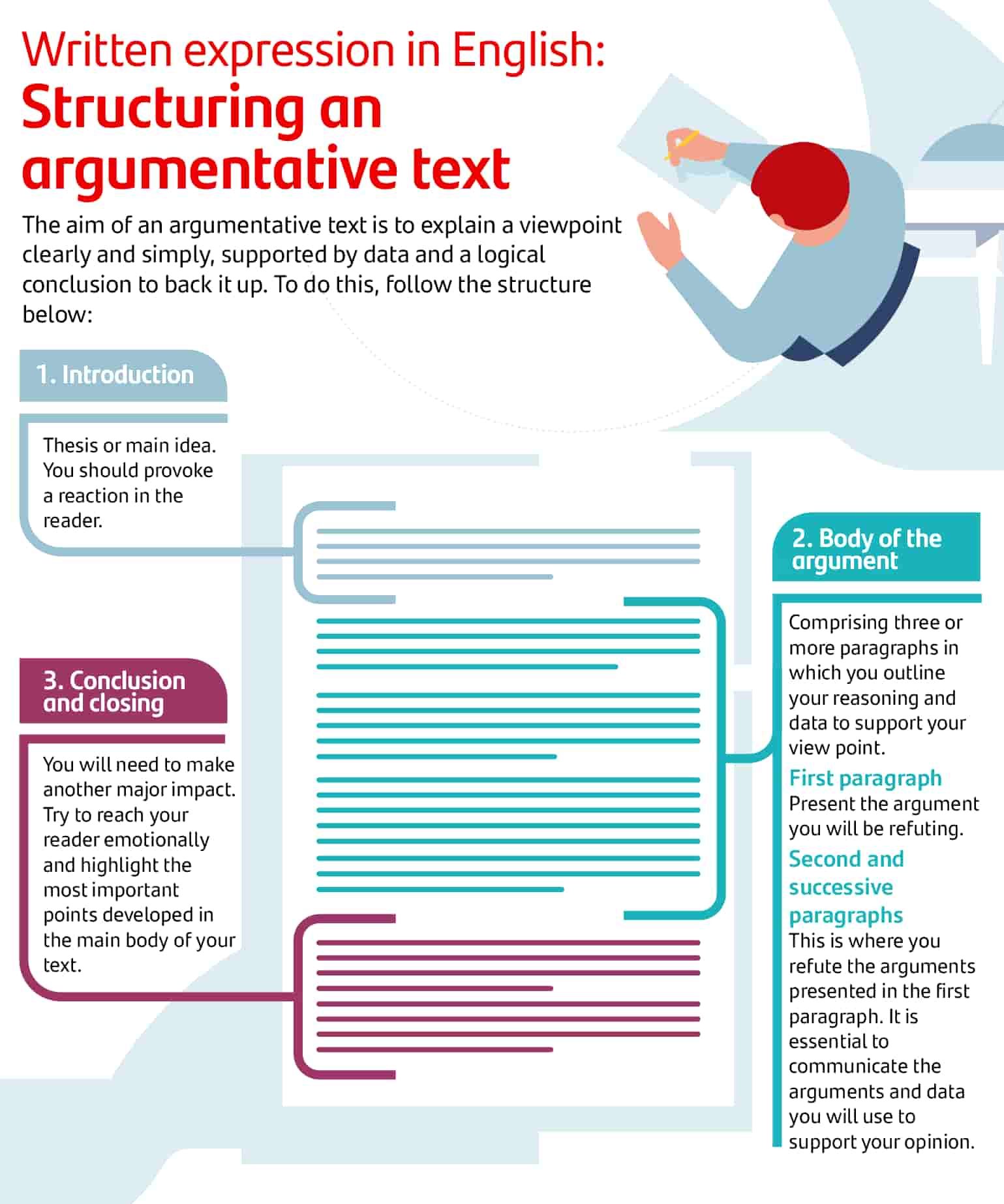Argumentative text structure: A guide to improving written expression in English
Written expression is an essential skill in academic and professional environments. From the briefest of communications to essays, texts follow certain rules and writing conventions that change from one language to another, so it's important to know the differences. One vital step is the structuring of each type of text. In this article you will find handy information about the structure of an argumentative text in English.
What is an argumentative text?
An argumentative text is one of the most common types of text and is characterised by trying to persuade the reader of an idea by providing arguments. Writing such a text is a common task in language-learning, and is widely used as an assessment tool in official exams. Normally, specific guidelines have to be followed, although these may change according to the context. The general features of an argumentative text are:
- It champions a specific position.
- It offers data and arguments to defend that position.
- It takes opposing arguments into account, and discusses these.
- It can deal with a wide variety of topics.
How is an argumentative text structured?
The aim of an argumentative text is to put forward a viewpoint clearly and simply, supported by data and a logical conclusion to back it up. To do this, follow the structure below:
- Introduction: briefly explain the subject matter dealt with in the text and provide the necessary background, so the reader can understand your position. The introduction presents the thesis, which is the main idea argued for in the text.
- Body of the argument: this usually consists of three or more paragraphs where the reasoning and data that support your point of view are outlined. Each paragraph should focus on a different idea and should begin by clearly establishing the theme you wish to develop. The opposing arguments that you'll be refuting should be included here along with your own, although the order will depend on the approach you take.
- Conclusion: this last paragraph should focus on the final argumentation underpinning the thesis, synthesising the most important arguments as developed in the preceding paragraphs. Here, you should avoid including new ideas, and instead highlight the fundamental points in favour of your argument.

How to write an argumentative text in English
1. Introduction
The introduction should be concise. This is not the time to develop in-depth arguments or contrast different points of view. The main purpose here is to establish a state of play (a summary of the current situation), which helps us to understand the text without entering into too much detail, while also clarifying the subject matter and stance to be taken. Key features of this opening paragraph are:
- Precision
- Brevity
- Effectiveness
In the introduction, you should provoke a reaction from the reader, whether this be to predispose them towards your argument, generate interest, or anything else. There are many ways to generate interest in the reader, from opening your text with a question and its answer (at the start or end) to beginning with a specific fact and outlining the reasons why it is important. There is a wide range of tools that can be useful to achieve the desired effect. It is also highly recommendable to use short, concise sentences when you still haven't mastered the language.
2. First paragraph of the body
The first paragraph sets out the opinion that you're going to try to refute. Although there are other ways to organise an argumentative text, this is one of the most common. It's important to focus only on the issues that will be discussed in the text itself and not to leave any loose ends, since the purpose of these opposing arguments is to spark a dialogue with matters or ideas you intend to develop.
One common approach to outline these ideas is to use conjunctions of opposition such as although or even though. The key to this first paragraph is to present the arguments in order of priority (and bearing in mind how they relate to one another) to later discuss them in the same order.
3. The second and subsequent paragraphs
The second paragraph is where arguments presented in the first are refuted. If the paragraph is too long or you need new arguments or ideas for your discussion, you can separate it into as many paragraphs as you need. Here, the important thing is to present the arguments and data that you will use to support your opinion.
Any paragraphs following this one should also include arguments in favour, without the need to contrast them with others. Look for new ideas to include in support of your stance, and continue the discussion in the third and successive paragraphs. Remember to always follow a logical order, maintaining the order of ideas set out previously, connecting them to themes to one another and opening new paragraphs for each change of idea.
4. Conclusion and closing
Here, you will need to make another major impact like the one in the introduction. Although this time you can write a little more, try to reach your reader emotionally and highlight the most important points developed in the main body of your text. This is not the place to include new ideas. Instead, focus on summarising and creating the desired effect on the reader, so that your argument is better established and the main points stand out above others.

Following a structure is the first step to writing a sound argumentative text, an essential practice in the process of learning any new language such as English. To properly organise a text, you will need to work on learning the essential vocabulary as well as developing your communication skills in the language concerned.
Language skills hold significant value in today's job market. Do you want to develop professional skills that will help you access better job opportunities? Discover Santander Open Academy, the training space you need to keep growing.
Join our global platform for learning and professional development and access courses at zero cost, training content in a wide range of formats and scholarships from leading universities and institutions.
If, like us, you believe that we should never stop learning, sign up here and find out what we have for you!
More interesting posts to read...
-
 12/04/2024 | Santander Universidades
12/04/2024 | Santander UniversidadesGrowth mindset: examples in the workplace to develop the right attitude toward challenges
Card text -
 01/03/2024 | Santander Universidades
01/03/2024 | Santander UniversidadesThe sandwich technique: how to deliver criticism in an assertive way
Card text

